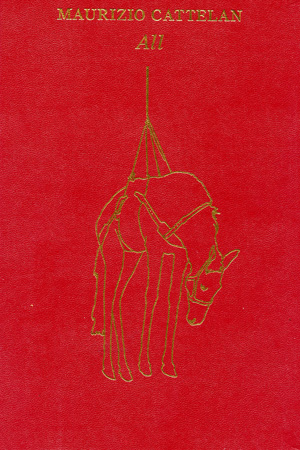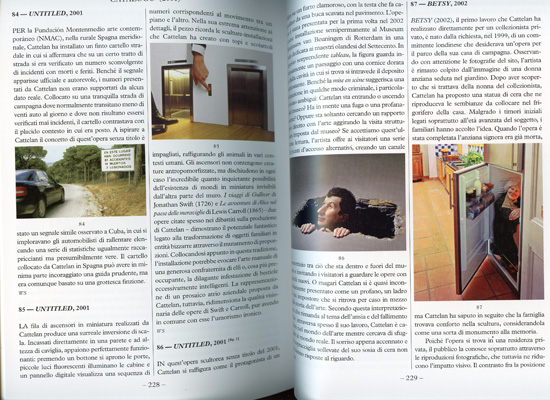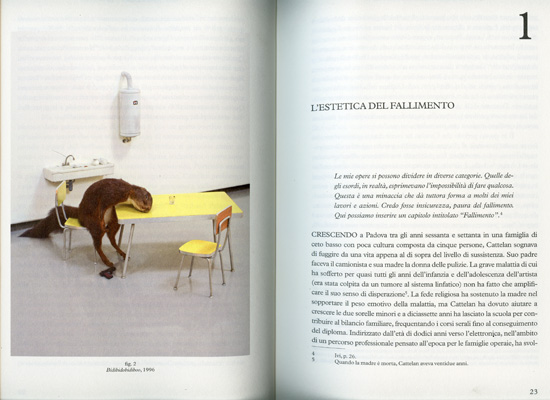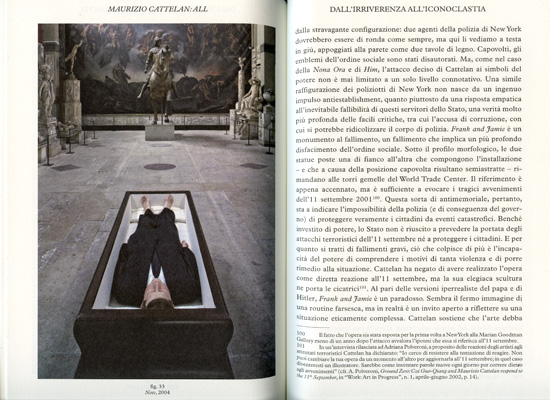 Ho comprato la versione italiana del catalogo della mostra di Maurizio Cattelan al Guggenheim di New York. È un catalogo ordinario e anomalo insieme. Trattandosi di Cattelan stupisce l’aspetto ordinario, ovviamente. Ma partiamo dalla “normalità” (in senso cattelaniano). Il catalogo è anomalo perché è confezionato come un libro di medio formato, la copertina rigida rossa con le scritte incise in oro, la carta pregiata, i caratteri con le grazie. Un libro all’antica. Penso che l’idea sia legata al secondo aspetto, quello ordinario: al contrario della mostra – che potremmo definire “una retrospettiva impazzita” – il catalogo dà conto in modo ordinato e sistematico di tutte le opere dell’artista. Anzi, si tratta di una vera e propria monografia che la curatrice Nancy Spector dedica all’artista con rigore e austerità. A me pare che parallelamente al complicato lavoro di allestimento, Cattelan abbia commissionato (o accettato) un’opera di riflessione sulla propria carriera che non mi pare fino a oggi qualcuno avesse mai tentato. Nelle interviste dei giorni scorsi la Spector ha affermato che Cattelan non viene preso sul serio e con questo libro mi sembra che abbia voluto colmare questa lacuna. Del resto lo stesso Cattelan nel libro-intervista con Catherine Grenier afferma che “pochissimi critici sono stati in grado di fare un vero e proprio lavoro di scavo per arrivare a capire quello che faccio”. Qui 179 pagine su 255 ospitano un lungo saggio della Spector dai capitoli con titoli altisonanti: “L’estetica del fallimento”, “Dimensioni politiche”, “Dualismo e morte”, “Dall’irriverenza all’iconoclastia”, “Cultura dello spettacolo e immagine mediata”. Il testo è farcito di note ed è completato con una lunga bibbliografia. Il resto delle pagine sono il vero e proprio catalogo in cui di ciascuna opera è mostrata con una piccola immagine e un paragrafo di spiegazione circa le circostanze e spunti per l’interpretazione.
Ho comprato la versione italiana del catalogo della mostra di Maurizio Cattelan al Guggenheim di New York. È un catalogo ordinario e anomalo insieme. Trattandosi di Cattelan stupisce l’aspetto ordinario, ovviamente. Ma partiamo dalla “normalità” (in senso cattelaniano). Il catalogo è anomalo perché è confezionato come un libro di medio formato, la copertina rigida rossa con le scritte incise in oro, la carta pregiata, i caratteri con le grazie. Un libro all’antica. Penso che l’idea sia legata al secondo aspetto, quello ordinario: al contrario della mostra – che potremmo definire “una retrospettiva impazzita” – il catalogo dà conto in modo ordinato e sistematico di tutte le opere dell’artista. Anzi, si tratta di una vera e propria monografia che la curatrice Nancy Spector dedica all’artista con rigore e austerità. A me pare che parallelamente al complicato lavoro di allestimento, Cattelan abbia commissionato (o accettato) un’opera di riflessione sulla propria carriera che non mi pare fino a oggi qualcuno avesse mai tentato. Nelle interviste dei giorni scorsi la Spector ha affermato che Cattelan non viene preso sul serio e con questo libro mi sembra che abbia voluto colmare questa lacuna. Del resto lo stesso Cattelan nel libro-intervista con Catherine Grenier afferma che “pochissimi critici sono stati in grado di fare un vero e proprio lavoro di scavo per arrivare a capire quello che faccio”. Qui 179 pagine su 255 ospitano un lungo saggio della Spector dai capitoli con titoli altisonanti: “L’estetica del fallimento”, “Dimensioni politiche”, “Dualismo e morte”, “Dall’irriverenza all’iconoclastia”, “Cultura dello spettacolo e immagine mediata”. Il testo è farcito di note ed è completato con una lunga bibbliografia. Il resto delle pagine sono il vero e proprio catalogo in cui di ciascuna opera è mostrata con una piccola immagine e un paragrafo di spiegazione circa le circostanze e spunti per l’interpretazione.
Il testo della Spector occorrerà leggerlo con attenzione. Io mi sono limitato a leggere le due pagine (troppo poche) dedicate a “La nona ora”, l’opera del papa colpito dal meteorite. Devo dire che, purtroppo, mi hanno molto deluso. Complice un tipico pregiudizio stereotipato per la Chiesa cattolica, l’analisi è abbastanza piatta e fa fuori le cose assai più profonde che Cattelan ha detto circa quell’opera sia nelle interviste in occasione della mostra milanese del 2010, sia nel libro delle Gernier. Peccato.

 I bought the Italian version of the catalog of the exhibition by Maurizio Cattelan at the Guggenheim in New York. It is a catalog of ordinary and abnormal together. The catalog is anomalous because it is packaged as a book of medium size, hard cover with red inscriptions in gold, high-quality paper, with the characters through. An ancient book. I think the idea is linked to the second aspect, the ordinary one: contrary to the shows the catalog provides an orderly and systematic account of all the works of the artist. Indeed, it is a veritable monograph devoted to the artist, curator Nancy Spector wrote it with rigor and austerity. It seems to me that in parallel to the complicated set-up work, Cattelan has commissioned (or accepted) a work of reflection on his career so far I do not think anyone had ever attempted. In interviews in recent days Spector said that Cattelan is not taken seriously and this book seems to me that he wanted to fill this gap. Moreover Cattelan in the same book-length interview with Catherine Grenier says that “few critics have been able to do a proper job of digging to get to understand what I do”. Here are home to 255 of 179 pages of a long essay by Spector chapters with high-sounding titles: “The aesthetics of failure”, “political dimension”, “Dualism and death”, “From the irrilevance to the iconoclasm”, “Culture and entertainment mediated image”. The text is stuffed with notes and is completed with a long bibbliography. The rest of the pages are the real catalog in which each work is shown with a small picture and a paragraph of explanation about the circumstances and starting points for interpretation.
I bought the Italian version of the catalog of the exhibition by Maurizio Cattelan at the Guggenheim in New York. It is a catalog of ordinary and abnormal together. The catalog is anomalous because it is packaged as a book of medium size, hard cover with red inscriptions in gold, high-quality paper, with the characters through. An ancient book. I think the idea is linked to the second aspect, the ordinary one: contrary to the shows the catalog provides an orderly and systematic account of all the works of the artist. Indeed, it is a veritable monograph devoted to the artist, curator Nancy Spector wrote it with rigor and austerity. It seems to me that in parallel to the complicated set-up work, Cattelan has commissioned (or accepted) a work of reflection on his career so far I do not think anyone had ever attempted. In interviews in recent days Spector said that Cattelan is not taken seriously and this book seems to me that he wanted to fill this gap. Moreover Cattelan in the same book-length interview with Catherine Grenier says that “few critics have been able to do a proper job of digging to get to understand what I do”. Here are home to 255 of 179 pages of a long essay by Spector chapters with high-sounding titles: “The aesthetics of failure”, “political dimension”, “Dualism and death”, “From the irrilevance to the iconoclasm”, “Culture and entertainment mediated image”. The text is stuffed with notes and is completed with a long bibbliography. The rest of the pages are the real catalog in which each work is shown with a small picture and a paragraph of explanation about the circumstances and starting points for interpretation.
The text of Spector need to be read carefully. I have limited myself to read the two pages (too few) dedicated to “The Ninth Hour”, the work of the Pope struck by a meteorite. I must say that, unfortunately, I was very disappointed. Accomplice in a typical stereotypical prejudice for the Catholic Church, the analysis is fairly flat and take out things much deeper Cattelan said about this work is in the interviews for the exhibition in Milan in 2010, both in the book of Gernier. Too bad.

